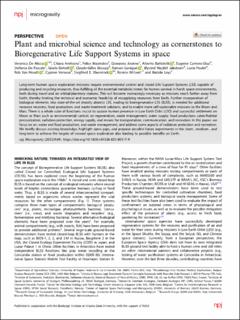Plant and microbial science and technology as cornerstones to Bioregenerative Life Support Systems in space
| dc.contributor.author | De Micco, Veronica | |
| dc.contributor.author | Amitrano, Chiara | |
| dc.contributor.author | Mastroleo, Felice | |
| dc.contributor.author | Aronne, Giovanna | |
| dc.contributor.author | Battistelli, Alberto | |
| dc.contributor.author | Carnero-Diaz, Eugenie | |
| dc.contributor.author | De Pascale, Stefania | |
| dc.contributor.author | Detrell, Gisela | |
| dc.contributor.author | Dussap, Claude-Gilles | |
| dc.contributor.author | Ganigué, Ramon | |
| dc.contributor.author | Jakobsen, Øyvind Mejdell | |
| dc.contributor.author | Poulet, Lucie | |
| dc.contributor.author | Van Houdt, Rob | |
| dc.contributor.author | Verseux, Cyprien | |
| dc.contributor.author | Vlaeminck, Siegfried E. | |
| dc.contributor.author | Willaert, Ronnie | |
| dc.contributor.author | Leys, Natalie | |
| dc.date.accessioned | 2024-02-22T07:53:05Z | |
| dc.date.available | 2024-02-22T07:53:05Z | |
| dc.date.created | 2023-09-08T13:10:24Z | |
| dc.date.issued | 2023 | |
| dc.identifier.citation | npj Microgravity. 2023, 9 (1), . | en_US |
| dc.identifier.issn | 2373-8065 | |
| dc.identifier.uri | https://hdl.handle.net/11250/3119148 | |
| dc.description.abstract | Long-term human space exploration missions require environmental control and closed Life Support Systems (LSS) capable of producing and recycling resources, thus fulfilling all the essential metabolic needs for human survival in harsh space environments, both during travel and on orbital/planetary stations. This will become increasingly necessary as missions reach farther away from Earth, thereby limiting the technical and economic feasibility of resupplying resources from Earth. Further incorporation of biological elements into state-of-the-art (mostly abiotic) LSS, leading to bioregenerative LSS (BLSS), is needed for additional resource recovery, food production, and waste treatment solutions, and to enable more self-sustainable missions to the Moon and Mars. There is a whole suite of functions crucial to sustain human presence in Low Earth Orbit (LEO) and successful settlement on Moon or Mars such as environmental control, air regeneration, waste management, water supply, food production, cabin/habitat pressurization, radiation protection, energy supply, and means for transportation, communication, and recreation. In this paper, we focus on air, water and food production, and waste management, and address some aspects of radiation protection and recreation. We briefly discuss existing knowledge, highlight open gaps, and propose possible future experiments in the short-, medium-, and long-term to achieve the targets of crewed space exploration also leading to possible benefits on Earth. | |
| dc.language.iso | eng | en_US |
| dc.rights | Navngivelse 4.0 Internasjonal | * |
| dc.rights.uri | http://creativecommons.org/licenses/by/4.0/deed.no | * |
| dc.title | Plant and microbial science and technology as cornerstones to Bioregenerative Life Support Systems in space | en_US |
| dc.title.alternative | Plant and microbial science and technology as cornerstones to Bioregenerative Life Support Systems in space | en_US |
| dc.type | Peer reviewed | en_US |
| dc.type | Journal article | en_US |
| dc.description.version | publishedVersion | |
| dc.source.pagenumber | 0 | en_US |
| dc.source.volume | 9 | en_US |
| dc.source.journal | npj Microgravity | en_US |
| dc.source.issue | 1 | en_US |
| dc.identifier.doi | 10.1038/s41526-023-00317-9 | |
| dc.identifier.cristin | 2173517 | |
| cristin.ispublished | true | |
| cristin.fulltext | original | |
| cristin.qualitycode | 1 |

